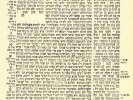
Sacred Texts Judaism Talmud Index Previous Next


Babylonian Talmud, Book 10: History of the Talmud, tr. by Michael L. Rodkinson, [1918], at sacred-texts.com
We have to repeat again that we do not see any reason why the more prominent sages should not be mentioned. To quote all of those omitted, both of Tanaim and Amoraim, with the sources where they are taken from would take a whole volume and we also would not like to devise an entirely new arrangement contrary to Strack, Mielziner and others whose authority we respect. However, we cannot refrain from calling the attention of students to the fact that after a good deal of deliberation and search we cannot find any reason why the most prominent sages should not be placed among the founders of the Talmud.
Take, for instance, Abtulmus, who is mentioned in Tract Erubin, Chapter III., Mishna 4, who, according to R. Jose, testified in the name of five elders, etc., and who is also mentioned several times in the Gemara and is not identical with Abtalyon who was in an earlier time. Take also Baba b'Buta who, was in the time of Herod the Great, and who was a disciple of Shamai and cannot be counted of his school as he was of those who were troubling themselves to establish the Halakha in accordance with the school of Hillel. and whom the Talmud put up as an example of morality. (See Weiss "Geschichte der jüdichen Tradition," Vol. I., p. 168.}
We also do not find among them Elazai b. Arach, whom we have added, the distinguished one of the five disciples of R. Johanan b. Zakkai, and also no mention of b. Bag Bag, b. Haij Haij, b. Buchre, and Papus b. Jehudah. The contemporaries of these were Johanan b. Zakkai, Jehudah b. Bathyra, etc., etc., all of whom are mentioned in the Mishnayoth as great authorities, who according to our opinion ought to be placed among the Tanaim, founders of the Mishna.
There is mentioned by Strack and Perferkowitz (the latter counts Elasur b. Arach and Simon Shezur), Ben Patturo or Ben Pature, who is to be found only once in the whole Talmud, namely in Baba Metzia, p. 149. Let us quote his statement: "If two were on the road (in the desert), and one of them has a pitcher of water which is sufficient for one only until he may reach an inhabited place, but if both would use it both would die before reaching a village, and Ben Patturo lectured that in such a case it
is better that both should drink and die than that one should witness the death of his comrade." This teaching seems to us to be of the Essenes as it is not in accordance with the Talmudical spirit, and as his own name is not known (there are many who were named after their fathers only as Ben Dama, b' Bathyra, b' Azai, but their own name however is known) we are inclined to say that he lived at a much earlier time and it should read Ben Pantira, who was in his youth a disciple of Jehoshua b' Prachyah 1 and it would not be surprising that his lecture was stated in his name as so it was done with Elisha b' Abbuyah in Tract Aboth, Chapter IV., notwithstanding that thereafter he separated himself from his colleagues and was named Acher.
106:1 i.e., Jesu b. Joseph Pantira, who is usually so mentioned in Tosephta (Chulin, v. 22), and in the Palestinian Talmud several times. In some places Jesu b. Pantira, and in other places Jesu Pantira and also Ben Pantira. Concerning Jehoshua b. Panchia, who was his teacher, according to the Talmud, we are inclined to say there were two Jehoshuas rather than to claim that there were two Jesuses.